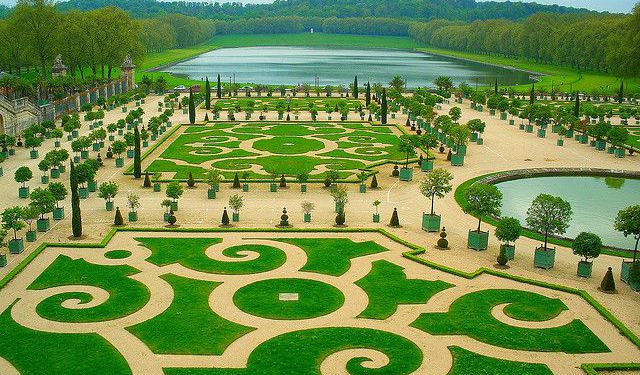
Hameau de la Reine (Queen’s Hamlet), Versailles (must see)
When you visit the Queen’s Hamlet, it will be up to you to decide if it was built on the whim of a frivolous queen or for a lonely young woman who wanted to escape disapproving courtiers and lose herself for a few hours by pretending to be an ordinary woman.
The Hamlet was built between 1785 and 1792 by Richard Mique, the queen’s favorite architect. It consisted of twelve cottages, five of which were set aside for the queen, the rest were part of a working farm that produced dairy products, fruit, vegetables and eggs for the queen.
The Queen's House, her billiard room and boudoir are in the centre of the Hamlet and in spite their rustic exteriors, the interiors were richly decorated with tapestries, stucco work and wooden paneling.
The Warming Room- or warming room at the back of the Queen’s House was used as a pantry, a bakery and a kitchen where meals were prepared for the queen and her guests. The Moulin (mill) has a steam-driven wheel, but the building was never used to grind anything as there is no grinding wheel inside.
The lighthouse shaped Marlborough Tower was used for storage, while the Laiteries (dairies) nearby produced butter, cream and cheese in one part, while the second was used as the Queen’s Tasting Room.
The Farm is set a little apart from the rest of the Hamlet and had its own fields, vegetable gardens, vineyards and orchards. Sheep and cows were imported from Switzerland and raised on the farm. Marie-Antoinette often dressed as a peasant and milked the cows.
The Columbier (dovecote) was filled with poultry; the Grange which also served as a ball-room was destroyed during the Revolution. The Housekeeper’s Cottage is the building nearest the lake.
The Hamlet was built between 1785 and 1792 by Richard Mique, the queen’s favorite architect. It consisted of twelve cottages, five of which were set aside for the queen, the rest were part of a working farm that produced dairy products, fruit, vegetables and eggs for the queen.
The Queen's House, her billiard room and boudoir are in the centre of the Hamlet and in spite their rustic exteriors, the interiors were richly decorated with tapestries, stucco work and wooden paneling.
The Warming Room- or warming room at the back of the Queen’s House was used as a pantry, a bakery and a kitchen where meals were prepared for the queen and her guests. The Moulin (mill) has a steam-driven wheel, but the building was never used to grind anything as there is no grinding wheel inside.
The lighthouse shaped Marlborough Tower was used for storage, while the Laiteries (dairies) nearby produced butter, cream and cheese in one part, while the second was used as the Queen’s Tasting Room.
The Farm is set a little apart from the rest of the Hamlet and had its own fields, vegetable gardens, vineyards and orchards. Sheep and cows were imported from Switzerland and raised on the farm. Marie-Antoinette often dressed as a peasant and milked the cows.
The Columbier (dovecote) was filled with poultry; the Grange which also served as a ball-room was destroyed during the Revolution. The Housekeeper’s Cottage is the building nearest the lake.
Want to visit this sight? Check out these Self-Guided Walking Tours in Versailles. Alternatively, you can download the mobile app "GPSmyCity: Walks in 1K+ Cities" from Apple App Store or Google Play Store. The app turns your mobile device to a personal tour guide and it works offline, so no data plan is needed when traveling abroad.
Hameau de la Reine (Queen’s Hamlet) on Map
Sight Name: Hameau de la Reine (Queen’s Hamlet)
Sight Location: Versailles, France (See walking tours in Versailles)
Sight Type: Attraction/Landmark
Sight Location: Versailles, France (See walking tours in Versailles)
Sight Type: Attraction/Landmark
Walking Tours in Versailles, France
Create Your Own Walk in Versailles
Creating your own self-guided walk in Versailles is easy and fun. Choose the city attractions that you want to see and a walk route map will be created just for you. You can even set your hotel as the start point of the walk.
Versailles Introduction Walking Tour
Versailles, a wealthy suburb of Paris some 20 kilometers southwest of the capital, is steeped in grandeur and regal history. Known worldwide for its opulent palace – the residence of French royalty, this small town offers much more than just its royal gates. Versailles is a living museum of French architecture and aristocratic life and is historically known for numerous treaties signed there,... view more
Tour Duration: 2 Hour(s)
Travel Distance: 3.5 Km or 2.2 Miles
Tour Duration: 2 Hour(s)
Travel Distance: 3.5 Km or 2.2 Miles
Versailles Gardens Walking Tour
Spread across a vast (800-hectare) area, the Versailles Gardens are the quintessential example of regal grandeur and meticulous French landscape design. Most of its feature areas – known as 'groves' – were created by King Louis XIV’s chief landscape architect André Le Nôtre. Key among the garden's numerous attractions is the Orangerie Fountain, which sets the tone for its... view more
Tour Duration: 3 Hour(s)
Travel Distance: 3.5 Km or 2.2 Miles
Tour Duration: 3 Hour(s)
Travel Distance: 3.5 Km or 2.2 Miles


